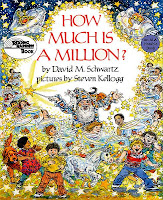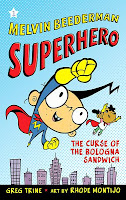We generally think of math and literacy as different subjects however there are many interesting books that include math concepts.
2 x 2 = Boo! : A Set of Spooky Multiplication Stories by Leedy, Loreen. Holiday House, 1995. Grades 2-4
Halloween characters including bats and witches introduce the multiplication table.
Anno's Mysterious Multiplying Jar by Masaichiro and Mitsumasa Anno. Philomel Books, 1983. Grades 2-5
This story is about one jar and what was inside it. The concept of factorials is illustrated inside a mysterious jar where there is some water, that becomes a sea, in that sea, there is an island, and so on until the reader has counted to the 10 factorial or 3,628,800!
 The Cat in Numberland by Ivar Ekeland. Cricket Books, 2006. Grades 3-5
The Cat in Numberland by Ivar Ekeland. Cricket Books, 2006. Grades 3-5
The resident cat at Numberland's Hotel Infinity, where there's never a vacancy, but there's always room for more, is perplexed. All the rooms are full of Numbers, both Odds and Evens when Zero, the Letters and the Fractions show up. After some room switching everyone still has a room.
Counting on Frank by Rod Clement. G. Stevens Children's Books, 1991. K-Grade 3
A boy and his dog Frank illustrate counting, size comparison, and mathematical facts in an amusing style.
Edgar Allan Poe's Pie Math Puzzlers in Classic Poems by Patrick Lewis. Harcourt Children's Books, 2012. Grades 3-7
Classic poems, such as Edgar Allan Poe's The Raven and Langston Hughes' April Rain Song, are rewritten with the addition of math.
Do the Math: Secrets, Lies, and Algebra by Wendy Lichtman. Greenwillow Books, 2007. Sequel Do the Math: the Writing on the Wall. Grades 6-8
In California thirteen-year-old Tess uses mathematical concepts to help her understand things in her life including her changing friendships, discovering a classmate stole a test and a investigating suspicious death.
Frankie Pickle and the Mathematical Menace by Eric Wight. Simon & Schuster Books for Young Readers, 2011. Grades 2-5
In the third Frankie Pickle book Frankie must use his division skills to overcome the Mathematical Menace when he is transported by his math quiz to Arithmecca, a world filled with number monsters.
Geek High. by Piper Banks. NAL Jam, 2007.
Grades 8-10
After fifteen-year-old math genius Miranda Bloom is forced to plan the Notting Hill Independent School for the Gifted’s Snowflake Gala, she has to find a date because her stepsister is going with her crush. Sequel: Geek Abroad.
The Great Math Tattle Battle by Anne Bowen. A. Whitman, 2006.Grades 1-3
Harley has been best math student and the biggest tattle-tale in second grade until Emma Jean joins his class. Soon the two become rivals that use their math skills to tattle on each other.
How Much is a Million? by David M. Schwartz. HarperCollins, 1985. Grades K-3
The Mathematical Magician Marvelossissimo helps a group of children visualize with some amazing examples how much is a million really is. For example, if you wanted to count to a million, it would take 23 days! A similar approached is explored in A Million Dots by Andrew Clements.
Island of The Unknowns by Benedict Carey. Amulet Books, 2009. Grades 6-10.
The summer before seventh grade Lady Di and Tom Jones solve math equations to crack a code from their beloved math tutor who is one of the many people that mysteriously disappearing from their small island. Previously published under the title The Unknowns.
A collection of poems about math topics such as fractions, time and Pythagoras by a variety of poets.
Math created by Basher, written by Dan Green. Kingfisher, 2010. Grades 4-7.
Mathematical terms such as zero, subtract, pi, quadrilaterals, and ratio are personified as Japanese-style cartoon that explain who they are.
Math Curse by Jon Scieszka and Lane Smith. Viking, 1995. Grades 2-4
A girl’s math anxiety increases when her math teacher, Mrs. Fibonacci , tells the class that almost everything can be thought of as a math problem. The next morning she wakes up to find that she is cursed because everything she sees is in terms of math such as how can twenty-four birthday cupcakes can be split among twenty-five people.
One Grain of Rice: A Mathmatical Folktale by Demi. Scholastic Press, 1997. Grades 2-4
During a famine in India a clever village girl named Rani outwits the raja by asking for one grain of rice as a reward. Then she asks “each day for thirty days you will give me double the rice you gave me the day before. Thus, tomorrow you will give me two grains of rice, the next day four grains of rice, and so on for thirty day."
Sir Cumference Series by Cindy Neuschwander. Charlesbridge, 1999. Grades 3-7
In each book Radius, the son of Sir Cumference and Lady Di of Ameter, needs to complete a mathematical quest. In the first book Radius must find the magic number known as pi in order to restore his father, who has been turned into a dragon, to his original shape.
Two of Everything : a Chinese folktale retold by Lily Toy Hong. Whitman, 1993. Preschool-Grade 2
One spring morning Mr. Haktak, a poor old Chinese farmer, discovers a brass pot that magically doubles whatever is placed inside it. Once at home Mr. and Mrs. Haktak think their luck has finally changed until Mrs. Haktak doubles after falling into the pot.
A Very Improbable Story: a Math Adventure by Edward Einhorn. Charlesbridge, 2008. Grades 2-5
Ethan wakes up one morning with a talking cat on his head. The cat tells Ethan that he will get off only after Ethan wins a game of probability. The two look at groups of coins, socks, and cereal pieces, but will Ethan beat Odds before leaving for the big soccer game?
What's Your Angle Pythagoras? Charlesbridge, 2004. Grades 3-5.
In ancient Greece, young Pythagoras is a curious child who discovers a special number pattern and uses it to solve problems involving right triangles. Sequel: Pythagoras and the Ratios.






























































